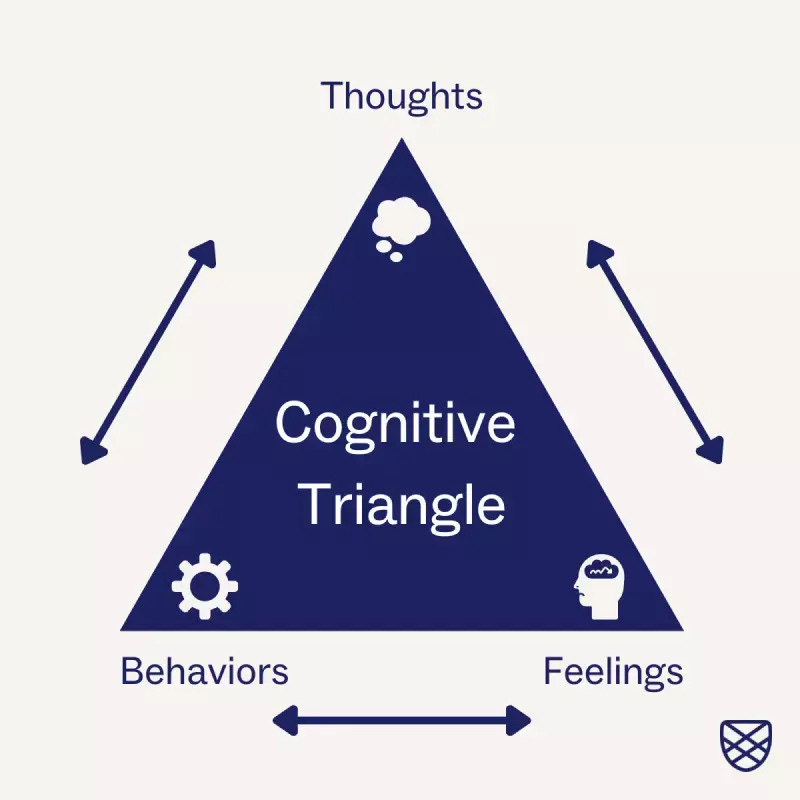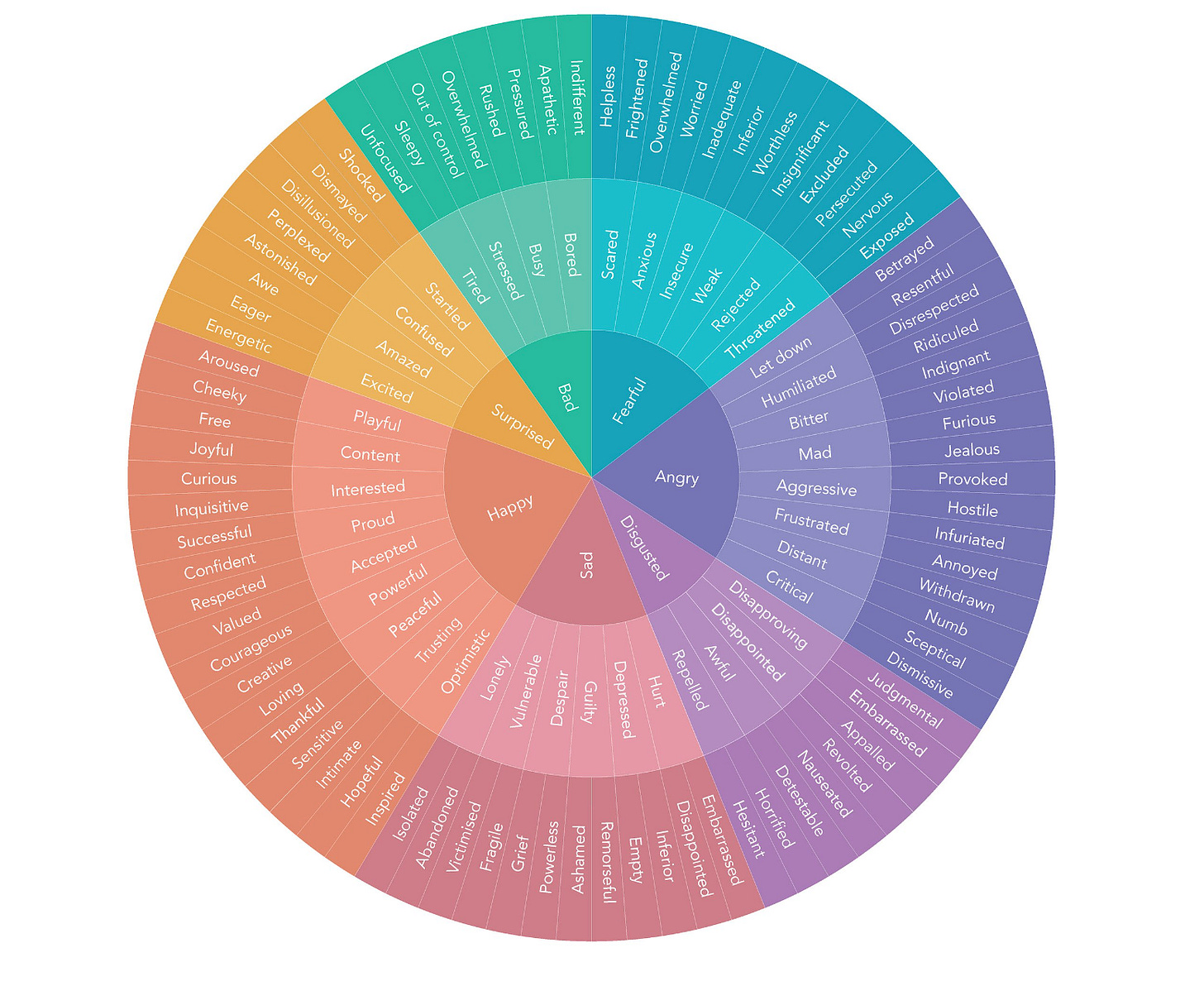How to add emotion to your copy (with examples).
Voicemail #14
Sup, nerds.
Last week I sent out a missive with 5 factors that make your brand name more memorable. I then tried to apply those factors to messaging in general.
This week I want to dig into my favorite one of those five: ✨ emotions ✨
Why make your messaging more emotive?
A few years ago, my therapist rocked my world when he told me, “Grace — your emotions aren’t real. They’re signals that tell you something is happening.”
At the time, my emotions were running the god damn show inside my head. Learning that they weren’t reality, but rather a reaction to a stimulus literally changed my life.
This ^ is the foundational idea of Cognitive Behavioral Therapy (CBT).
I won’t go into the details (I’m not a therapist), but the idea is pretty simple. In CBT, you learn that your Thoughts, Feelings, and Behaviors are three closely connected but veeeery separate things. They all affect each other, but you can control them individually.
I like to think of these as three levers in the brain. When you pull one of the levers, it influences the other two.
I got to know CBT very well during my mental health glow up a few years ago.
At the time, I was going through clinical depression. As part of my treatment, I spent about a year writing quick journal entries throughout the day with three questions:
What am I doing right now?
How is that making me feel?
How is that affecting my thoughts?
What can I do to change any negative patterns right now?
It was an incredibly powerful tool. I started to recognize that if I Felt bad about something, it was usually because I was either Behaving in a way that didn’t benefit me (laying in bed) or Thinking negative thoughts (“I am literally the worst person on the planet right now.”).
Thanks to CBT, I really got to see the power of how changing a Behavior (even something as simple as unloading the dishwasher) made me Think better thoughts about myself, which made me Feel better in general.
The practice helped me crawl out of depression — and it’s given me a framework for thinking about marketing and writing ever since.
Many B2B marketers focus too much on the Behavior and the Thoughts, but forget how powerful Feelings can be.
This is a broad, sweeping statement for sure. But it tracks based on my eight years of experience in B2B.
Most companies and PMMs I work with are very good at the logical side of things. As marketers, our goal is always to get people to Behave a certain way by performing an action (usually book a call with our sales team). We need them to pull that lever inside their head.
But to get them to do that, we need to get them to Think and Feel a certain way about the problem we help them solve.
Many B2B marketers have the Thinking part down. We know our product features and their tactical benefits.
We can explain it in a clinical, logical way — and that’s the problem.
It’s how we end up with messaging like this (which I took from a real website, but altered slightly to hide the company category):
Managing and monitoring thousands of data points and maintaining multiple strategies can be overwhelming.
Does that make you want to buy this product?
Didn’t think so.
The truth is that logic is important. It helps people justify their decision. It helps them Think about things differently.
But if nobody wants to read your messaging, they’ll never get to the logical part of your argument for why you should exist.
If you want to hook readers and make your logical arguments memorable, you need to wrap them up in emotional packages.
So, how do you actually add emotions to your messaging?
I’m very much an intuitive writer, but I took a step back and thought about how I map emotion when I’m creating messaging/copy.
Here’s my process:
Step 1: Identify the emotions you want to use.
Look at the different sections of your messaging and take a moment to ask how people feel when they’re in that part of the journey. What emotions would help make the logical parts of your message more noticeable?
Psychologists today agree that there are a few basic emotions. I learned in my therapy that there are 6, but this Calm article cites 7.
These emotions can be broken up into primary, secondary, and tertiary emotions. The best way to look at them is on an emotion wheel:
When you’re writing your messaging, take a look at the wheel and try to figure out what emotions you can play around with.
Let’s find the emotional words from our example above. I’ve bolded them out.
Managing and monitoring thousands of data points and maintaining multiple strategies can be overwhelming.
Use the chart above to find Overwhelmed. Where does it sit? If you look, you’ll see it’s part of Anxiety, which is part of Fear.
That tracks. When I get overwhelmed with work, for example, it’s usually because my workload is too big. I become nervous that I can’t get everything done on time, which makes me afraid that my clients will hate me.
Step 2: Sit in that feeling and try to describe it.
Identifying the emotion is the first part — but it’s not enough to tell people that something is overwhelming. You have to make them feel it, and the only way to do that is to feel it yourself.
In our example, try to imagine the last time you felt overwhelmed by something. What do you notice in your body?
One helpful tool here might be an emotion thesaurus (I use this one). It’ll give you some good ideas for how to describe that emotion.
Example: Using my emotion thesaurus, I can see that common signals of fear include staring, but not seeing, clammy hands, gripping something so hard your knuckles turn white.
You don’t need to do anything with this information yet (that’s the next step). The point here is just to grab data about what an emotion looks like.
Step 3: Paint a picture with your words.
Now’s the fun part. Take those emotions and descriptions and start using them to paint a picture in your messaging and copy.
When you tell a reader that something is scary, they don’t feel it. When you can show readers what it’s like to be scared or overwhelmed, they feel it, too.
Example: Let’s use the data from Step 2 and apply it to the copy from Step 1:
Before:
Managing and monitoring thousands of data points and maintaining multiple strategies can be
overwhelming.After:
Stop white-knuckling your way through thousands of data points across multiple strategies.
See how that feels a little more visceral? If you did that to 20% of the sentences on a given page, you’d have something pretty spectacular.
The most successful companies I work with have a strong sense of Feeling behind what they’re selling — and it comes from the top.
Emotion often gets kicked around in B2B, or left to the “creatives” to execute on it.
But if you want to make something truly meaningful, everyone on the team has to feel it. It has to be a part of your brand and your values.
It also needs to be part of the messaging documents. Your writers will never feel empowered to take bolder, creative risks if the person controlling messaging doesn’t empower them to do it.
So next time you’re writing a messaging doc, try to see where you can add a bit more emotion to it — either in the brief you’re giving writers, or in the messaging itself.
Your team will thank you (and so will your audience).
This week’s writing hack: assonance
Assonance is when a vowel sound repeats throughout your sentence. It kind of gives your sentences and internal rhyme scheme, which makes them memorable.
Take this example: The early bird catches the worm. In this case, the “-ir” sound is repeated throughout the line, which makes it sound nice to the ear.
Another one that I love is He’s cruisin’ for a bruisin’. Doesn’t that just sound kind of fun? (Not the bruising, I mean.)
Assonance is a great tool to have in your writing toolbox. It makes your sentences sound a little meatier and gives them texture that’s hard to ignore. When you get strategic and choose sounds that evoke a certain emotion, you kind of become unstoppable.
Let’s play with the example from above: Stop white-knuckling your way through every tax season.
Here’s how we can use assonance to evoke different emotions:
Ominous: Taxes looming over your to-dos?
Annoying: Tax season sneaking up on your team?
Stuck: Tax season send you scrambling into a panic?
Your homework this week: play around with your headline and see if you can add some assonance to it.
Hit respond and let me know what you came up with.
Stuff I’m digging from other people this week.
Lizzie Davey asking an important question: Is AI de-skilling us?
Joe Daniels’ story about a monstrous fish that learns to love himself was one of the most delightful things I’ve seen on LinkedIn in a while.
Marcus Taylor wrote a very kind post about how he and I worked together on a recent project.
Stuff I’ve been writing this week.
I’m getting back into the groove of things.
How to make your writing sound more human (this kind of took off — it’s a good one!)
Thanks for being here.
I’m really, genuinely honored to have you as a subscriber. It means a lot to me. If you have ideas on how I can add more value to your experience, shoot me a message. I’m just an email away.
Otherwise, if you liked this post, feel free to share the publication by clicking the button below.
See you next week.



